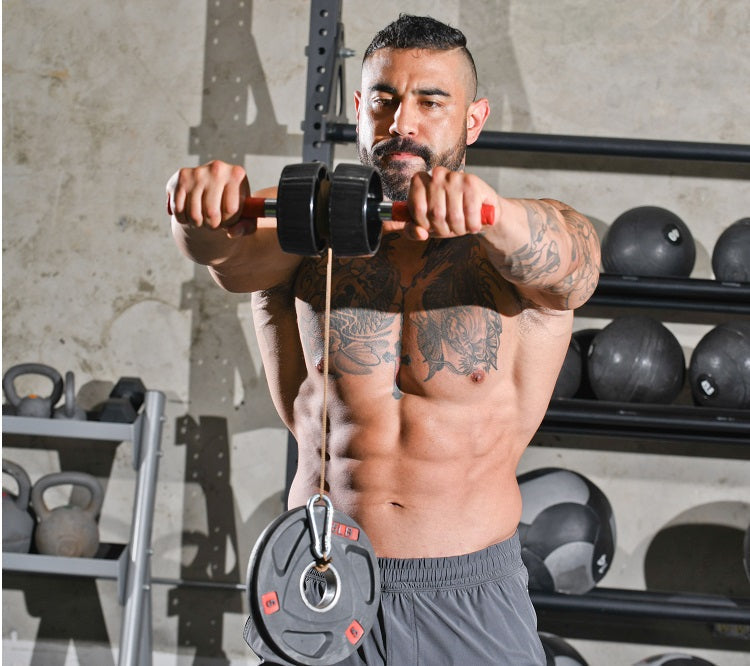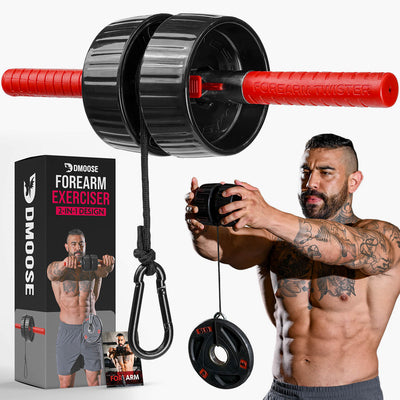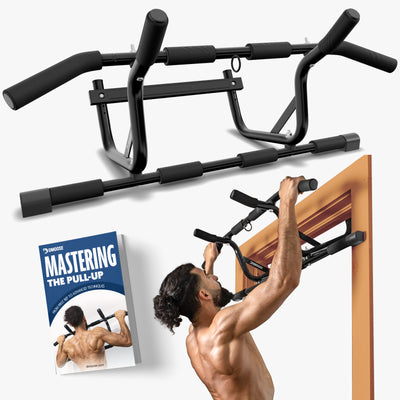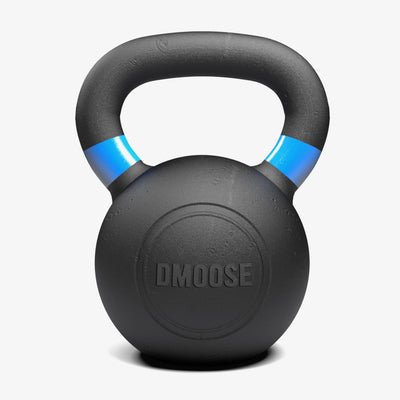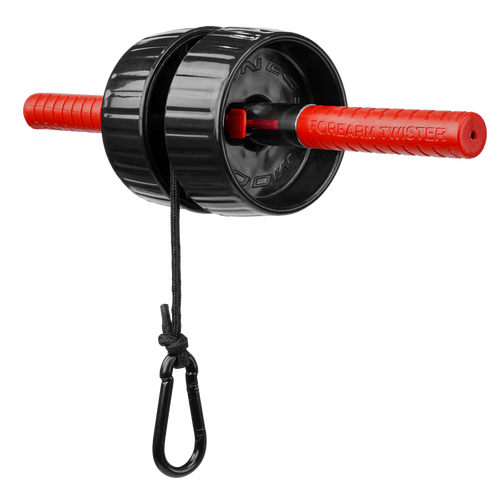It's easy to get caught up in focusing on the "showy" muscles like the chest, abs, and biceps, and we bet there's one area you've probably overlooked: Your forearms.
However, the truth is that your forearms play a vital role in overall upper body strength and aesthetics.
But why do so many people neglect their forearms during workouts?
According to a study, six weeks of training with a hand ergometer significantly increased grip strength and endurance in both trained and untrained forearms. This shows that consistent exercise can enhance overall forearm strength.
Another study found that both functional and traditional resistance training methods effectively improved muscular strength and endurance in young adults, with notable increases in forearm girth and overall balance.
Given how important forearm training is, this blog will guide you through 10 powerful exercises to build massive, detailed, and aesthetically impressive forearms.
Essential Gear for Forearm & Wrist Workouts
The right equipment is essential for getting the most out of your forearm and wrist workouts. Below is a list of six must-have tools to help you strengthen these muscles effectively. Using high-quality gear can make a noticeable difference in your results. Check out the links to find premium equipment that supports muscle growth and helps you reach your fitness goals faster.
How to Get Bigger Forearms? 10 Proven Exercises
Focusing more on building massive forearms will help you get more strength. So it's important to include exercises for bigger forearms in your routine. Gradually, you will be able to develop bigger forearms that will help you lift more weight and perform other exercises easily.

So, how to build bigger forearms? Here are the top ten workouts for bigger forearms
1. Forearm Rolling

Forearm rolling is one of the best exercises for forearms that helps improve grip strength and muscle endurance. Using a forearm wrist strengthener and exerciser, you can effectively train your wrist and forearm muscles for better performance and stability.
This simple yet powerful movement is ideal for athletes, climbers, or anyone learning how to get bigger forearms through consistent and controlled training.
How to do it
- Secure a weight to the end of the strengthener’s rope.
- Hold the strengthener with both hands at shoulder width.
- Rotate the handle to wind the rope around it, lifting the weight.
- Slowly unwind the rope, lowering the weight back down.
- Perform for a set number of repetitions.
2. Palms-Up Wrist Curls

The palms-up wrist curl is a classic forearms workout that specifically targets the muscles on the underside of your forearm. It’s an excellent movement for developing grip strength and forearm size while improving wrist stability and control.
Including this exercise regularly will help you learn how to grow forearms effectively while reducing the risk of wrist fatigue during heavier lifts.
How to do it
- Sit on a bench and hold a barbell in your hands with palms facing up.
- Rest your forearms on your knees, allowing your wrists to hang slightly over the edge.
- Curl your wrists upward, pause briefly, and then slowly lower the bar to the starting position.
3. Palms-Down Wrist Curls

Wondering how to get bigger forearms and stronger wrists? The palms-down wrist curl is one of the best exercises for forearms that strengthens the top side of your forearm while improving grip control and wrist mobility.
By targeting the extensors, this movement helps balance your forearm development, improves grip strength, and supports injury prevention.
How to do it
- Sit on a flat bench with your feet spread slightly to the sides.
- Hold a barbell with an overhand grip, palms facing down, hands shoulder-width apart.
- Lean forward so your forearms rest comfortably on your thighs or the bench edge.
- Inhale and lower the barbell slowly using only your wrists.
- Exhale and curl the bar upward by flexing your wrists.
- Repeat for the desired number of reps.
4. Farmer’s Carry

The farmer’s carry is one of the most functional workouts for forearms that builds grip endurance, stability, and overall upper body strength. It also improves posture and enhances core strength.
By carrying heavy weights over a distance, you train the forearm flexors intensely, which helps build big forearms and improves total-body coordination. You can use dumbbells or kettlebells for this exercise.
How to do it
- Stand upright with a dumbbell or kettlebell on each side of your body.
- Keep your shoulders back and chest up as you squat slightly to grip the weights.
- Stand tall, engaging your core, and start walking in small, steady steps.
- Focus on maintaining good posture and grip throughout the movement.
- Place the weights down gently, rest briefly, and repeat.
5. Resistance Band Pull-Up

Looking for how to grow forearms at home without heavy weights? Resistance band pull-ups are a simple yet effective forearms workout that builds strength and muscle size using minimal equipment.
This variation uses resistance bands and a pull-up bar to assist your movement, making it a great way to increase your pulling power and forearm endurance while progressing toward unassisted pull-ups.
How to do it
- Secure a resistance band over the pull-up bar and loop it around your knees or feet.
- Grab the bar with a shoulder-width grip, palms facing away.
- Inhale and pull yourself up until your chin passes the bar.
- Exhale and lower yourself back down slowly to the starting position.
- Repeat for 8–12 reps with control.
Related Article: Top 25 At-Home Exercises for Beginners
6. Farmer’s Walk

The Farmer’s Walk is one of the most effective workouts for forearms and overall strength. This exercise not only enhances grip endurance but also improves posture and core stability while helping you develop big forearms over time.
It’s a simple yet powerful movement that can easily fit into any forearms workout routine. The key is to maintain proper form and gradually increase the load for progressive results.
How to do it
- Stand upright and hold a dumbbell or kettlebell in each hand.
- Keep your shoulders back, chest up, and core engaged.
- Walk forward 25 to 50 feet while maintaining control and good posture.
- Set the weights down carefully, rest, and repeat for multiple rounds.
Over time, increase the weight or walking distance to build endurance and forearm thickness effectively.
7. Trap Bar Carry

The trap bar carry is a powerful compound movement that builds grip strength, core stability, and upper body power. It’s one of the best exercises for forearms because it allows you to handle heavier loads than traditional carries.
Unlike the farmer’s carry, this variation uses a trap bar instead of dumbbells or kettlebells, putting greater tension on your grip and forearms while engaging your traps, lats, and back muscles for full-body strength.
How to do it
- Stand inside the trap bar with your feet hip-width apart and arms relaxed by your sides.
- Bend slightly at the hips and grasp the handles with a neutral grip.
- Engage your core, stand tall, and lift the bar by extending your hips and knees.
- Walk a controlled distance while keeping your shoulders tight and your core braced.
- Lower the bar safely and repeat for multiple sets.
8. Plate Pinches

Plate pinches are an underrated but incredibly effective forearms workout that strengthens both your grip and wrist stabilizers. Depending on the grip you use, this exercise can target different muscle groups in your forearms for well-rounded development.
Using an overhand grip engages the wrist extensors, while a supinated grip emphasizes the wrist flexors. Consistent plate pinches will improve grip endurance and help build big forearms that enhance your lifting performance.
How to do it
- Place two weight plates together with the smooth sides facing out.
- Grip them tightly using your fingers and thumb in a pinching motion.
- Lift the plates off the ground and hold them for as long as possible.
- Lower them carefully and repeat for several rounds.
9. Pull-Up Bar Hang

The pull-up bar hang is a simple yet powerful forearms workout that strengthens your grip, wrists, and upper body. It’s often used as a warm-up or cool-down for other upper-body workouts, but it can also stand alone as an effective strength-building exercise.
While it primarily targets the back muscles, including the lats, traps, and rhomboids, this movement also helps develop big forearms since your grip and forearm muscles work hard to support your entire body weight during the hang.
How to do it
- Use a bench or step to comfortably reach your pull-up bar.
- Grab the bar with an overhand grip, hands shoulder-width apart.
- Lift your feet off the ground and hang with your arms straight.
- Keep your shoulders engaged, avoiding a passive hang.
- Hold the position for 20–60 seconds, then rest and repeat.
10. Hammer Curl

The hammer curl is one of the most effective exercises for forearms and biceps. It helps build big forearms by targeting both the brachioradialis (outer forearm muscle) and the biceps brachii, promoting overall arm thickness and strength.
This compound-style movement engages multiple muscle fibers, making it more effective for strength and mass development compared to isolation exercises. Adding hammer curls to your forearms workout routine will improve grip, wrist stability, and arm definition.
How to do it
- Hold a pair of dumbbells at arm's length by your sides with your palms facing inward.
- Keep your elbows tucked close to your body and upper arms stationary.
- Curl the dumbbells upward toward your shoulders while maintaining a neutral grip.
- Pause briefly at the top, feeling the contraction in your forearms and biceps.
- Slowly lower the weights back to the starting position and repeat.
Why Should I Train My Forearm Muscles
Training your forearm muscles is extremely important, as it provides numerous benefits beyond aesthetics. Strong forearms give a major advantage to athletes, gym-goers, and anyone involved in manual labor or activities that demand a powerful grip.
Increased Forearm and Grip Strength
Many people focus on developing bigger muscle groups but overlook one of the most essential areas: the forearms. Incorporating exercises for forearms helps strengthen the muscles that cross your hands, wrists, and elbows. This results in improved grip strength and endurance, allowing you to handle heavier weights with greater control during your workouts.
Strong forearms make everyday tasks easier and enhance athletic performance, giving you the foundation to lift, pull, and hold more effectively.
Improved Coordination and Balance
Performing forearms workouts regularly enhances muscle coordination during exercises and daily movements. The stronger and more balanced your forearms are, the better stability you’ll have when engaging other major muscle groups such as your shoulders, chest, and back.
With improved coordination and balance, you can lift heavier weights safely and perform more repetitions with proper form, reducing fatigue and risk of injury.
Better Muscle Growth
When training for muscle gain, it’s easy to focus only on large muscle groups like the chest, back, and legs. However, strong forearms play a vital supporting role in nearly every upper-body movement. Developing your forearms improves your ability to lift heavier loads, which promotes greater muscle growth throughout the arms and upper body.
Over time, consistent forearm training leads to bigger, stronger arms and more balanced overall development.
Reduced Risk of Repetitive Strain Injuries
Repetitive strain injuries, often caused by repetitive motion or poor wrist mechanics, can be prevented by building stronger forearms. Regular forearms workouts enhance grip stability, strengthen connective tissues, and support joint integrity, allowing you to perform daily tasks or gym exercises without strain.
Additionally, these exercises improve blood circulation, promoting faster recovery and increasing oxygen and nutrient delivery to the muscles for optimal performance.
Related Article: 5 Reasons Why Wrist Training is Important for Bodybuilders
FAQs
1. What are the best forearm exercises for beginners?
Palm-up and palm-down wrist curls, along with wrist extensions, are some of the best exercises for beginners. These movements effectively target your forearm muscles and help you build a strong foundation for forearms workouts.
2. How does forearm training work?
Forearm training involves exercises that strengthen the muscles of your forearms, improving endurance, flexibility, and grip. These workouts include gripping, extension, and rotational movements, all of which play a role in developing stronger and more functional arms.
3. What forearm exercise is most effective?
While the reverse wrist curl using an EZ bar is excellent for building the forearm extensor muscles, there isn’t one single “most effective” exercise. A combination of workouts for forearms such as wrist curls, hammer curls, and grip holds is ideal for developing well-rounded strength and size.
4. How to build massive forearms with tendonitis?
If you’re dealing with tendonitis, focus on low-impact exercises for forearms such as light wrist curls, grip squeezes, and mobility drills. Use lighter resistance bands or weights and maintain proper form to prevent aggravation. Gradually increase the load and allow enough rest between workouts. Always consult a healthcare professional for personalized guidance.
5. Can you build forearms without weights?
Yes, you can build your forearms without weights by performing bodyweight and resistance-based exercises. Movements like towel wringing, wrist push-ups, and fingertip planks are excellent for building forearm strength. You can also use resistance bands or grip tools to enhance muscle activation and endurance.
6. Can skinny forearms get bigger?
Yes, skinny forearms can get bigger with consistent training and proper nutrition. Incorporate exercises like wrist curls, reverse curls, and grip-strengthening movements into your forearms workout. Add compound lifts like pull-ups and deadlifts to stimulate muscle growth and eat a balanced, protein-rich diet to support muscle repair and development.
The Verdict
Strong and well-developed forearms are essential for achieving overall fitness and athletic performance. This guide covered some of the most effective exercises for forearms that help build strength, size, and endurance. However, your results depend not only on consistency but also on how well you perform each movement.
Using the right equipment can make a significant difference in your training progress. The DMoose Forearm Strengthener is one of the best tools for developing bigger forearms. It enhances hand strength, improves wrist mobility, and allows you to perform high-intensity workouts safely and efficiently. Its non-slip grip provides stability and promotes better blood circulation, helping you build powerful forearms that support both your gym performance and daily activities.
Incorporate this essential equipment into your training routine and start your journey toward stronger, more defined forearms today.
Reading List
5 Reasons Why Wrist Training is Important for Bodybuilders
Blow Up Your Forearms Using a Forearm Twister
10 Advanced Exercises to Take Your Arms to the Next Level
How to Strengthen Grip — Best Exercises to Improve Your Grip Strength & Wrist Mobility
How to Fix the Issue of Losing Your Grip During Lifting
How to Strengthen Wrists: Stretches, Exercises, and Tips
Build Forearm Strength by Mastering These 6 Band Exercises for Powerful Grips
Article Sources
- Yasuda, Y., & Yasuda, Y., & Miyamura, M. (1983). Cross transfer effects of muscular training on blood flow in the ipsilateral and contralateral forearms. European Journal of Applied Physiology and Occupational Physiology, 51(3), pp. 321–329. DOI: https://doi.org/10.1007/bf00429068.
- Weiss T, Kreitinger J, Wilde H, Wiora C, Steege M, Dalleck L, et al. (2010). Effect of functional resistance training on muscular fitness outcomes in young adults. Journal of Exercise Science & Fitness, 8(2), pp. 113-22. DOI: https://doi.org/10.1016/s1728-869x(10)60017-2.







